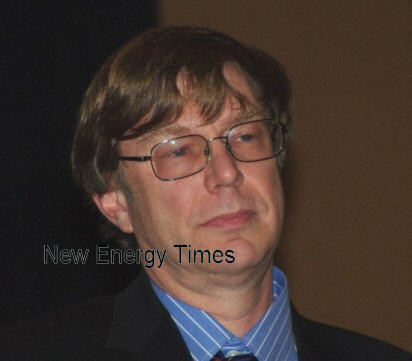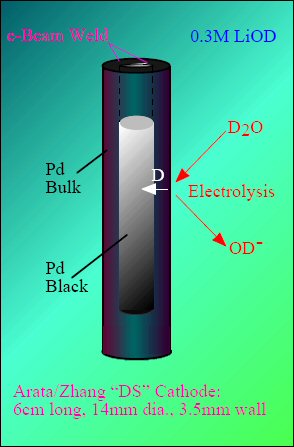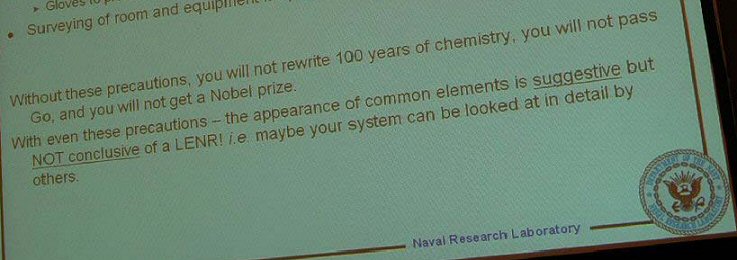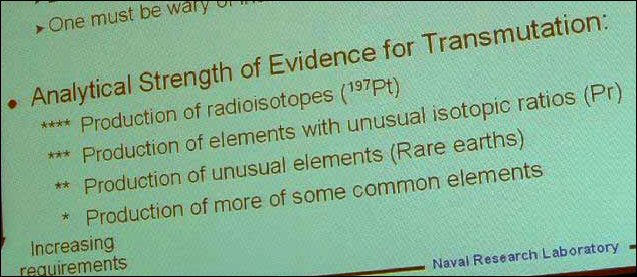|
⇐ Previous Article — Table of Contents — Next Article ⇒
New Energy Times home page
4. NRL 2008—The LENR Null Results Laboratory
By Steven B. Krivit
Introduction
According to research scientist David Kidwell and his colleagues at the Naval Research Laboratory (NRL), researchers who have made claims of LENR transmutations throughout the last two decades should be "embarrassed" about making such claims.
Kidwell's reasoning is that their results are caused by sources of contamination rather than LENR transmutations. Kidwell is one of several researchers at Washington, D.C.-based NRL who have been particularly well-funded in recent years to perform LENR research. Their group falls under the command of Bhakta Rath, associate director of research and head of the materials science and component technology directorate at NRL. Despite their abundant funding, they have had few LENR publications, and they have claimed no positive LENR results in nearly two decades.
David Kidwell
Photo: Edward Wall
 |
This article begins with a brief background on LENR transmutation, then reviews NRL/Kidwell's attempt to discredit LENR transmutation at the 14th International Conference on Condensed Matter Nuclear Science in August 2008.
A Few Words on Transmutation Terminology
Let's begin with a discussion about terminology. Readers likely have one of two perspectives.
Readers who view the change of deuterium and other materials in LENR experiments to helium-4 as a fusion process likely view the LENR transmutation experiments, which involve elements across the periodic table, as the result of some other, perhaps-unknown nuclear process.
Readers who view the change of materials to helium-4 as a transmutation reaction, perhaps caused by a neutron-catalyzed process, likely consider the distinction made by the first group of readers artificial and irrelevant. In other words, the whole field of LENR research comprises transmutation reactions of one sort or another. Perhaps it has very little to do with nuclear fusion, though it does have to do with other nuclear processes.
This article does not attempt to ascertain which view is more accurate. However, it assumes that "transmutation" experiments may involve changes to or from any elements heavier than the very lightest of the elements, hydrogen and helium, for example.
This article also does not explain the difference between the time-honored understanding and textbook definition of "nuclear fusion" and "neutron capture." That is discussed in "Neutron Capture Is Not the New Cold Fusion."
Localized Perspectives on LENR Transmutation Research
Many readers from the United States appear to see this subject from an entirely different perspective than readers from Russia, France, India, Japan and Ukraine, for example.
Many American LENR researchers believe that LENR transmutation is less important and less credible than the subset of experiments with deuterium-palladium and heavy water that reportedly produce heat and helium as their primary if not exclusive products.
In Russia, for example, the title of the local regional LENR conference series, "Russian Conference on Cold Nuclear Transmutation of Chemical Elements and Ball Lightning," reveals a broader view of the subject matter.
One of the most prominent LENR researchers in China, Xing Zhong Li, professor emeritus of Tsinghua University, who was the chairman of the Ninth International Conference on Cold Fusion, recently completed a transmutation experiment that replicated and confirmed a significant Japanese transmutation experiment.
Although Li was not able to attend and present his work at the American Chemical Society national meeting in San Francisco, California in March 2010, his abstract is informative.
"Nuclear transmutation was discovered on the surface of palladium film using scanning electron microscopy," Li wrote. "SEM analysis revealed that new elements (Cu, Zn, Si, etc.) were detected in the permeation area, but there were no such elements in the original palladium film or in the ring-shape area where no permeation happened."
However, reports of transmutation research at the two most recent ICCF conferences, ICCF-15 and ICCF-14, are difficult to find. ICCF originally meant International Conference on Cold Fusion. About 10 years ago, researchers in the field changed the meaning of ICCF to International Conference on Condensed Matter but kept the ICCF acronym, presumably because of their attachment to the concept of "cold fusion."
The ICCF-14 conference organizers initially did not include transmutations as part of the conference agenda, adding it only after several people protested. During ICCF-14, those organizers gained political control of the subsequent ICCF-15 and thus were able to continue a similar but less-obvious strategy to downplay transmutation research.
For a glimpse of the broad interest (outside the U.S.) in LENR transmutations, you have to go back to ICCF-13 in Russia (2007), ICCF-12 in Japan (2005) and ICCF-11 in France (2004).
One of the most comprehensive references on the worldwide research in LENR transmutations is a review presented at ICCF-10 in 2003 by George Miley, professor at University of Illinois.[1]
The French journal Science et Vie published a useful article on the topic in May 2004.
We cannot attempt to cover the broad extent of LENR transmutation research in this article. We direct readers to the Conferences page at the New Energy Times Web site.
Talbot Chubb's Review of Mitsubishi/Iwamura LENR Transmutations Claims
The rare strong enthusiasm about transmutation from Americans was evident after ICCF-10 in Cambridge (2003), in Talbot Chubb's Sept. 12 and Oct. 13, 2003, "News Flashes."
Chubb, now retired, is no newcomer to nuclear physics. Highlights of his long career in science include work on the Manhattan Project during World War II at Oak Ridge National Laboratory.
In his News Flashes, Chubb wrote about the experiments pioneered by LENR researcher Yasuhiro Iwamura, of Mitsubishi Heavy Industries, and the confirmatory replications at Osaka University from a group led by Akito Takahashi. In the late 1990s, Iwamura developed an innovative experiment to show LENR transmutations in a deuterium gas environment.
"The Osaka and Mitsubishi studies provide solid evidence that deuteron or alpha-addition nuclear reactions can be made to reproducibly occur on solid metal at a temperature below that of boiling water," Chubb wrote.
The essential part of the experiment is a substrate containing layers of palladium and calcium oxide. Atoms from the source element are placed on the surface. Deuterium gas is passed through the substrate. No energy, aside from the flowing deuterium and a small heater, is applied to the experiment. When Iwamura added cesium on the surface of a palladium complex, praseodymium gradually emerged on the surface and cesium gradually decreased after the palladium complex was subjected to deuterium gas permeation. The cesium ⇒ praseodymium change is one of several pairs of elemental transmutations he has demonstrated.
Chubb knew that the Iwamura work could not be explained easily by the "cold fusion" hypothesis, but he sensed that it was, in fact, part of a larger picture.
"The transmutations are not cold fusion results per se," Chubb wrote, "but are likely part of the same 'active deuterium' physics that is responsible for deuteron cold fusion."
Even though Chubb could not see a theoretical explanation for the Iwamura-type transmutations through the lens of his "cold fusion" perspective, he saw something profound:
|
The new discoveries remind one of the beginnings of neutron-capture physics. In 1932 Chadwick discovered the neutron. His neutrons were produced by the impact of alpha particles on beryllium. Within a few years a large number of previously non-existing types of nuclei were synthesized by exposure of various target elements to neutron irradiation. During these neutron-absorption studies uranium fission was discovered and the new element plutonium was synthesized. By the end of 1942 the first controlled nuclear reactor was already in operation. A nuclear power plant was generating electricity in 1955. |
NRL/Kidwell's Attempt to Discredit LENR Transmutation at ICCF-14
Let's start with the scientific aspects of Kidwell's 2008 presentation at ICCF-14 in Washington, D.C., Aug. 10-15, 2008.
His first 20 slides explain the intricacies of performing elemental trace analysis, his specialty. According to Kidwell, LENR researchers too easily fool themselves into thinking that they have observed nuclear transmutations when they are, in fact, seeing only contamination.
At about 10 minutes into his presentation (click for video), on slide 21, he refers to "Arata experiments" that show a three- to five-times increase of silver inside a palladium cathode after a LENR experiment. These measurements were performed by neutron activation analysis (NAA) at the University of Texas, Austin.
Kidwell was not sure about the exact source of the materials, as he told New Energy Times on Oct. 8, 2008. He thought they had come from SRI International and were from an Arata-Zhang replication experiment. He received them from Thomas Passell, a retired program manager for Electric Power Research Institute.
A cross-check of two of Passell's papers confirm that Passell had received the samples from Arata (not SRI) and given the samples to NRL around 2003 so NRL could determine the isotopic abundances of silver.[2,3] Kidwell said he had no contact with Arata.
At ICCF-14, Kidwell reported that he had performed a "bulk analysis" on the material and found 13 times more silver in the post-electrolysis sample than in the virgin sample, even more than was registered by the NAA at the University of Texas.
In this case, "bulk analysis" does not necessarily distinguish between the inner structure and the outer surfaces because the entire sample is vaporized; the inner structure and outer surfaces are averaged together.
"We showed, yes, there's about 13 times more silver in the material that underwent this Arata experiment than there was in the starting material," Kidwell said. "However, the isotopic ratio is normal, absolutely normal, no difference whatsoever between that and natural silver. How could that be? Where did the silver come from?"
This is potentially a key point: Researchers generally agree that, if measured isotopic ratios from an experiment for a given element are identical or nearly identical to ratios found in natural abundances, then the isotopes found in that experiment likely are from some kind of natural occurrence rather than, for example, a LENR transmutation.
For reference, Kidwell states in his paper that the natural ratio for silver's two isotopes is 52:48 (Ag107/Ag109). However, we have to take on faith Kidwell's claim that the ratio of the test sample is "absolutely normal," because his slides, recorded talk, and paper do not present his measurements for the Ag107/Ag109 post-electrolysis ratio.
Assuming the ratio is "absolutely normal," this still leaves the very significant mystery of how the silver content grew 13-fold. Kidwell is not without an answer, sort of. He speculates that trace amounts of silver present in the hollowed-out palladium cathode segregate and preferentially migrate from and through the walls of the cathode and contaminate the palladium-black powder inside the container during the experiment.

Arata-Zhang Double-Structure Cathode[4]
"Well, as it turns out, palladium is known to have silver added as a hardening agent," Kidwell said. "It's contained in this container, which has deuterium pumping through it.
“Some of that silver can migrate from container walls into the material on the inside, and of course it's going to be natural isotopic silver because it was natural isotopic silver on the outside of the container. We actually were not able to analyze the [actual] container. [Instead,] we were given part of [another] container [inaudible], and it actually contained about 0.008 percent silver."
Once Kidwell states the few scientific facts that he was able to obtain, he ties his hypothetical scenario together with a pair of pure guesses.
"I'm not sure that's sufficient," Kidwell said, "but once we analyzed the remaining container, I'm reasonably certain it had a higher concentration of silver."
First, he guesses about the amount of silver contaminate sufficient to explain the post-experiment silver. Second, he guesses that the container from the experiment had a higher concentration than the container he measured. His guesses suggest that his process may be based more on disbelief than data.
Failure to Test Actual Container
Kidwell's hypothesis has more problems. First, Kidwell states that the silver is "contained in this container," giving the impression that he found silver in the double-structure cathode used in the experiment. He did not. He tested a different container.
Kidwell's explanation requires that we take on faith that the original container (cathode), which he did not test, had at least 0.008 percent silver.
Failure to Test Whether 0.008 Percent is Sufficient
Kidwell's hypothesis requires us to take on faith that 0.008 percent silver, assuming that it or more was in the actual container, was a sufficient quantity of silver to cause a 13-fold increase of silver inside the center of the container, assuming silver can preferentially migrate through the palladium cathode.
Failure to Test Preferential Migration Speculation
Kidwell tested only for the presence of silver. He did not test to see whether silver, if present in sufficient amounts, can do as he speculates – preferentially migrate through the walls of this double-structure palladium cathode – in this specific experimental configuration.
Does solid silver segregate from palladium and migrate preferentially through solid palladium under these conditions? We do not know because Kidwell provides no facts to support his speculation.
Failure to Test Preferential Migration Against Gas Pressure Speculation
Next problem: Kidwell talks about the pressurized "container which has deuterium pumping through it."
Readers unfamiliar with the experiment might assume that Kidwell is suggesting that external pressure on the container (cathode) forced the silver in the container walls to migrate inward and contaminate the palladium-black in the center core of the container.
However, there is no external pressurization; the double-structure cathode is encumbered merely by the heavy water in which it sits. The heavy water undergoes electrolysis, and the evolved deuterium easily permeates the palladium over time.
Also, the pressure comes from inside the cathode, as Passell explained in his 2000 paper.
"Once the palladium powder is placed inside the core of the cathode," Passell wrote, "it had to be electron-beam welded because the deuterium pressure could reach extremely high values during electrolysis. In fact, some cathodes failed in a burst mode during electrolysis due to this pressure if not properly welded."
Kidwell might have known of the internal pressure, too. On Oct. 8, 2008, he wrote to New Energy Times and explained that the palladium-black samples from the experiment, as well as virgin material, were sent to him "blind," but he could observe differences between them.
"You could guess which was which by the powder size," Kidwell wrote. "The starting material was very fine, whereas the final material had conglomerated as if it was heated. Nano palladium will fuse at about 1/3 of the melting temperature, or about 500C."
Kidwell's attempt to explain the silver as something other than the result of LENR transmutation has more problems.
Failure to Disclose Previous NAA Results
Kidwell did not tell the audience at ICCF-14 and readers of his paper the rest of the story. NAA was performed on this palladium-black sample at the University of Texas, Austin, research reactor at the request of Passell. Passell is an expert in nuclear chemistry; he studied under Dr. Glenn T. Seaborg at the University of California, Berkeley.
Passell confirms, in his 2003 paper, that NAA does show a 2.87-fold increase in silver; he says that NAA, however, is not an optimal method to characterize isotopic ratios of silver.
Here are a few more things Passell reported from the two University of Texas NAA analyses of the Arata-Zhang palladium-black samples[2,3] from the same batch that Kidwell analyzed. Kidwell did not mention these facts:
- 8% increase in Pd110/108 ratio in sample B
-
2.87 times the silver-109 content in sample B
-
1.66 times the cobalt-59 content in sample B
-
15.2 times the zinc-64 content in sample B
-
0.6 times the gold-197 content in sample B
-
0.37 times (decrease) the iridium content in sample B
-
1.62 times the lithium-7/lithium-6 ratio in sample B
-
8 times the iridium content (PPM by weight) in sample A*
-
0.4 times (decrease) the iridium content by weight from sample B
-
6 times the iridium content (PPM by weight) in sample C
-
5.5 times the gold content by weight from sample A
-
0.1 times the gold content by weight from sample B
-
0.7 times the gold content by weight from sample C
-
24% increase in Pd-110/Pd-102 ratio relative to virgin palladium from sample A
-
6% increase in Pd-110/Pd-102 ratio relative to virgin palladium from sample B
-
21% increase in Pd-110/Pd-102 ratio relative to virgin palladium from sample C
|
In his 2000 paper, Passell reminds readers that the typical skeptical dismissal of LENR transmutation from electrolytic experiments, by cathodic deposition, cannot be used to explain away these results.
"The conventional explanation for such increases is the cathodic deposition of electrolyte impurities on the cathode surface," Passell writes. "However, all these samples were protected from the electrolyte inside the gas-pressure-tight hollow core of the cylindrical cathode."
Passell writes that researchers in the Department of Physics at Tsinghua University, Beijing, China, using a completely different type of LENR experiment, independently reported a similar "severe alteration" of the zinc isotopic ratio.[5]
Non-Technical Aspects of Kidwell's Presentation
Now let's look at the non-technical aspects of Kidwell's presentation.
Starting with slide 26, Kidwell explains to the audience how careful and proficient he is when he performs his trace analyses. He appears to be an expert, in precise command of his subject matter. He appears to be well-positioned to provide an authoritative opinion on trace analysis.
Kidwell suggests that LENR transmutation claims in general suffer weaknesses that reduce their credibility.
According to Kidwell, the transmutation claims of LENR researchers in general can be explained by their ignorance and carelessness. He also suggests that they are fooling themselves, and by implication, fooling others.
"If you have what you think you're making all over your room, do you really have it?" Kidwell said. "Or are you just fooling yourself from some random event?
"Without all these precautions, I wouldn't go talk to my colleagues. You're not going to rewrite 100 years of chemistry, you're not going to pass go and you're not going to win a Nobel Prize! With these cautions, you might go talk to your colleagues and say, 'Something unusual occurred.' But without them, I would just kind of be embarrassed."

Kidwell's 2008 Admonishment to LENR Researchers
(Source: Kidwell's ICCF-14 slides)
Readers can watch Kidwell's performance on video.
At the end of Kidwell's talk (21:10 in the full video), LENR researcher John Dash asked Kidwell an interesting question about the weakness of inductively coupled plasma mass spectrometry (ICP-MS), specifically when used for surface analysis of LENR experiments.
"I think it’s generally agreed that LENR is a surface effect," Dash said.
Kidwell nodded in agreement.
"ICP-MS is going to dilute whatever surface reaction you have," Dash continued.
Before Dash could ask his question, Kidwell explained that, in his procedure, he performs two analyses, a bulk analysis and a surface analysis, and "actually compares both of them."
A comparison between a bulk analysis and surface analysis won't resolve the problem that Dash was getting to. LENR is primarily a surface effect, and Kidwell washes the surface of his samples before analyzing them with ICP-MS. That won't fix the problem.
Kidwell defends his approach by stating that he does only a "limited etching" and removes only "about one to 10 micrograms per gram of palladium."
Dash reminds Kidwell of another weakness with his approach. Dash states that "hot spots," craters and ejecta, which are well-known LENR phenomena, are highly localized. Dash tells Kidwell that looking for transmutations on LENR cathodes can be like looking for a needle in a haystack.
Dash says that the process of doing surface analysis for LENR "needs to be looked at very carefully."
|
Summary of Weaknesses in Kidwell's Explanation of Silver "Contamination"
- University of Texas NAA confirms anomalous presence of silver.
-
Kidwell independently confirms anomalous presence of silver using alternate analytical method.
-
Kidwell fails to disclose his measurements for the Ag107/Ag109 post-electrolysis ratio.
-
Kidwell does not explain why silver atoms should preferentially segregate and migrate from a homogeneous solid solution of 0.008 percent silver in palladium to the surface of a palladium cathode.
-
Kidwell fails to provide any references for similar tests of silver atoms preferentially segregating and migrating through solid palladium.
-
Kidwell fails to test or cite any literature that supports his speculation that silver atoms can migrate inward, against a high outward pressure.
-
Kidwell fails to test for silver content in the cathode wall.
-
University of Texas NAA shows at least 11 isotopic anomalies in material used in that same experiment.
|
Using Kidwell's own scale, "Analytical Strength of Evidence for Transmutation," the Arata-Zhang experiment produced very strong evidence for transmutation.

Kidwell's "Analytical Strength of Evidence for Transmutation" Scale
(Source: Kidwell's ICCF-14 slides)
Based on the above facts, LENR researchers seem, in fact, to have rewritten 100 years of chemistry and may be on track for Nobel prizes.
The facts against Kidwell's contamination hypothesis far outnumber the facts in support of his hypothesis.
Which brings us to the next logical question. Who was Kidwell's intended audience? Was it, for example, Bill Wilson, program manager for the Defense Threat Reduction Agency, who was sitting in the ICCF-14 audience? Wilson has been making decisions to federally fund LENR research in the last few years.
Or was the audience the LENR researchers themselves? And why? New Energy Times does not have answers to these questions. The only thing we know for sure is that, as Kidwell told us, he was invited to speak at ICCF-14 by Michael Melich, a former NRL laboratory head who is now at the Naval Postgraduate School and seems to have a way of controlling LENR research at NRL. (See “NRL 2009—The LENR Null Results Laboratory, Again” in this report.)
In his 2008 presentation, Kidwell also briefly introduced some speculation about praseodymium, which has been a major component of LENR transmutation claims by Japanese researchers. Audience members would have to wait a year to see the relationship between Kidwell's remark about trace elements "all over your room" and praseodymium.
* 2000 paper says Indium in Table 1. This is an error; it should be Iridium.
References
1. Miley, G.H., and Shrestha, P., "Review of Transmutation Reactions in Solids," Proceedings of the Tenth International Conference on Cold Fusion, Cambridge, Mass., (2003)
2. Passell, T.O., and George, R., "Trace Elements Added to Palladium by Exposure to Gaseous Deuterium," Proceedings of the Eight International Conference on Cold Fusion, Lerici (La Spezia), Italy, (2000)
3. Passell, T.O., "Pd-110/Pd108 Ratios and Trace Element Changes in Particulate Palladium Exposed to Deuterium Gas," Proceedings of the Tenth International Conference on Cold Fusion, Cambridge, Mass., (2003)
4. McKubre, M.C.H. “Review of experimental measurements involving dd reactions” (PowerPoint slides), in Tenth International Conference on Cold Fusion. 2003. Cambridge, MA: LENR-CANR.org.
5. Mo, D.W., Cai, Q.S., Wang, L.M., Wang, S.Z., and Li, X.Z., “The Evidence of Nuclear Transmutation Phenomena in Pd- System Using NAA”, Proceedings of the Seventh International Conference on Cold Fusion, p. 259-263, Vancouver, B.C., Canada. ENECO: University of Utah Research Park (April 19-24, 1998)
⇐ Previous Article — Table of Contents — Next Article ⇒
| 
